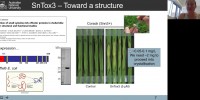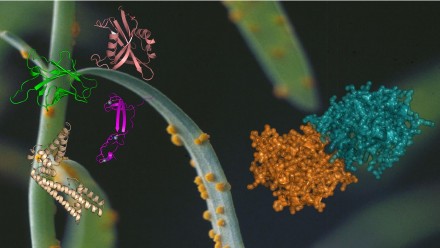Williams Group - Plant structural immunology
Our primary research objective is to understand the molecular basis of the interactions between plant hosts and the microorganisms, particularly fungi, that colonise them.
To do this we use molecular biology, protein biochemistry/biophysics and structural biology approaches.
Our research encompasses two broad themes
Theme 1: Plant immunity receptors - We want to understand how extracellular and intracellular immunity receptors in plants detect and respond to the recognition of effector (virulence) proteins from plant pathogens. This knowledge will be critical to understand the function of these receptors during resistance responses. It will also inform future gene-editing/genetic engineering approaches to manipulate and enhance plant disease resistance.
See publications 10.1073/pnas.1609922113, 10.1126/science.1247357, 10.1126/science.aax1911, 10.1073/pnas.1621248114, 10.1094/MPMI-03-11-0052, 10.1016/j.chom.2019.07.020
Theme 2: Pathogen effector (virulence) proteins - We want to understand how pathogen effector proteins perturb and/or activate defence pathways. To date, we have a poor understanding of effector virulence function, particularly in eukaryotic pathogens. I’m currently tackling this fundamental knowledge gap by studying multiple model and commercially relevant pathosystems.
See publications 10.1111/nph.17128, 10.1111/nph.17516, 10.1101/2020.05.27.120113, 10.1111/tpj.13228, 10.1111/mpp.12385, 10.1016/j.tplants.2017.06.013, 10.1111/mpp.12597
Group Leader
Postdoctoral Fellow
Divisional Visitor
Honours Student
ARC Future Fellow
ARC DECRA Fellow
PhD Students
Research Officers
Special Project Student
Selected publications
Theme 1:
- Williams SJ, et al (2014). Structural basis for assembly and function of a heterodimeric plant immune receptor. Science. http://science.sciencemag.org/content/344/6181/299
- Casey L, et al (2016). The CC domain structure from the wheat stem rust resistance protein Sr33 challenges paradigms for dimerization in plant NLR proteins. PNAS.
- Zhang X, et al (2017) Multiple functional self-association interfaces in plant TIR domains. PNAS. http://www.pnas.org/content/114/10/E2046
- Williams SJ, et al (2011) An autoactive mutant of the M flax rust resistance protein has a preference for binding ATP, while wild-type M protein has a preference for binding ADP. MPMI, https://apsjournals.apsnet.org/doi/abs/10.1094/MPMI-03-11-0052
Theme 2:
- Outram MA, (2021) The crystal structure of SnTox3 from the necrotrophic fungus Parastagonospora nodorum reveals a unique effector fold and provides insight into Snn3 recognition and pro-domain protease processing of fungal effectors. New Phytologist. https://doi.org/10.1111/nph.17516
- Sung YC†, Outram MA†, et al (2021). PR1‐mediated defence via C‐terminal peptide release is targeted by a fungal pathogen effector. New Phytologist. https://doi.org/10.1111/nph.17128
- Zhang X, et al (2018) Crystal structure of the Melampsora lini effector AvrP reveals insights into a possible nuclear function and recognition by the flax disease resistance protein P. MPP https://onlinelibrary.wiley.com/doi/abs/10.1111/mpp.12597
- Zhang X, et al (2017) Production of small cysteine-rich effector proteins in Escherichia coli for structural and functional studies. MPP. https://onlinelibrary.wiley.com/doi/abs/10.1111/mpp.12385
- Breen S, et al (2016) Wheat PR-1 proteins are targeted by necrotrophic pathogen effector proteins. Plant Journal. https://onlinelibrary.wiley.com/doi/abs/10.1111/tpj.13228
- Ve T, et al (2013) Structures of the flax-rust effector AvrM reveal insights into the molecular basis of plant-cell entry and effector-triggered immunity. PNAS. http://www.pnas.org/content/110/43/17594
For a full list of publications

Simon Williams

PS PhD Exit Seminar - From structure to function: characterising enzymatic effectors from pathogenic fungi

PS Seminar Series - PhD Exit Seminar - Structural investigation of the interaction between SIX effectors and resistance proteins

Australian Synthetic Biology Challenge: The Final Showcase

PS Webinar Series: The crystal structure of SnTox3 from the necrotrophic fungus Parastagonospora nodorum reveals a unique effector fold and insights into Kex2 protease processing of fungal effectors














